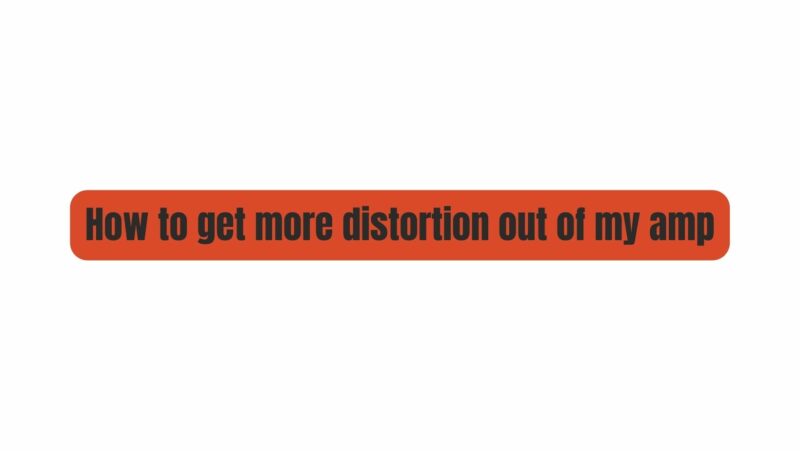There’s a certain magic in the gritty, snarling tones of an overdriven guitar amplifier. From the iconic crunch of classic rock to the searing screams of heavy metal, distortion is an essential element in the arsenal of any electric guitarist. But how do you get more distortion out of your amp while maintaining control and clarity? In this comprehensive guide, we will delve deep into the world of guitar amplification, exploring various techniques and gear adjustments to help you unlock the full potential of your amplifier.
- Understanding the Basics of Distortion
Before we dive into the ways to maximize distortion, it’s essential to understand the fundamentals of how it works. Distortion occurs when the input signal from your guitar exceeds the capacity of your amplifier to reproduce it cleanly. Instead, the signal is clipped, resulting in the characteristic saturated and fuzzy sound that we associate with distortion.
- Choosing the Right Amplifier
The first step in achieving more distortion is selecting the right amplifier. Different amps have varying degrees of gain and distortion potential. Here are some amplifier types to consider:
a. Tube Amplifiers: Known for their warm and natural distortion, tube amps are a favorite among many guitarists. They offer a smooth breakup and dynamic response.
b. Solid-State Amplifiers: Solid-state amps provide a cleaner tone at lower volumes but can still deliver distortion when pushed to their limits. They are often more affordable and lightweight than tube amps.
c. Modeling Amplifiers: Modeling amps emulate the characteristics of various amplifiers, allowing you to access a wide range of distortion tones. They are versatile and can be a great choice for experimentation.
- Mastering Gain Staging
Gain staging is the process of managing the level of gain at each stage of your signal chain. Proper gain staging is crucial for achieving the desired level of distortion without excessive noise or muddiness. Here’s how to do it:
a. Start with the guitar’s volume knob: Roll back the guitar’s volume knob to reduce input gain and clean up your tone.
b. Adjust the amplifier’s gain control: Gradually increase the amp’s gain until you reach the desired level of distortion. Be mindful of the amp’s natural breakup point, which can vary from model to model.
c. Experiment with an overdrive or distortion pedal: Adding a pedal to your signal chain can provide an additional layer of distortion and flexibility.
- Taming Your EQ
Equalization (EQ) plays a significant role in shaping your distortion tone. It allows you to emphasize or cut specific frequency ranges to achieve the desired sonic characteristics:
a. Boosting the mids: Increasing the midrange frequencies can make your guitar cut through the mix and sound more aggressive.
b. Scooping the mids: Scooping the mids (reducing the midrange frequencies) can result in a more modern and metal-oriented distortion tone.
c. Adjusting the treble and bass: Tweaking the treble and bass controls can help you fine-tune your tone’s brightness and low-end punch.
- Experimenting with Speaker Selection
The choice of speakers can significantly impact your distortion sound. Different speakers have unique tonal characteristics, so consider experimenting with speaker swaps or combinations to find the perfect match for your amp and playing style.
- Power Amp Distortion
While most of the distortion discussion focuses on preamp gain, don’t overlook the power amp section of your amplifier. Cranking up the master volume can drive the power amp tubes harder, producing a distinct and saturated distortion.
- Attenuators and Load Boxes
If you love the sound of a cranked amplifier but can’t play at high volumes, consider using an attenuator or load box. These devices allow you to push your amp to its limits without deafening yourself or disturbing your neighbors.
- Effects Pedals for Extra Flavor
Effects pedals can be invaluable tools for enhancing your distortion. Consider adding the following pedals to your setup:
a. Boost pedals: These can provide an extra kick to your amp’s gain stage.
b. Overdrive pedals: Stack them with your amp’s gain for increased saturation.
c. Distortion and fuzz pedals: Experiment with different types to find your preferred flavor of distortion.
d. EQ pedals: Use them to fine-tune your tone and sculpt your sound.
- Dialing in Your Playing Technique
Your playing technique plays a crucial role in achieving the desired level of distortion. Experiment with:
a. Picking dynamics: Adjust your picking intensity to control the level of distortion.
b. Vibrato and bending: Adding vibrato and bends can add depth and character to your distorted notes.
c. Palm muting: Mastering palm muting techniques can help you control the sharpness of your chugging riffs.
- Recording and Mixing Tips
When recording your distorted guitar parts, pay attention to mic placement, room acoustics, and the choice of microphones and preamps. In the mixing stage, use EQ, compression, and reverb to sculpt your guitar tone and make it sit perfectly in the mix.
Conclusion
Maximizing distortion from your guitar amplifier is a journey of discovery and experimentation. It involves selecting the right gear, understanding the principles of gain staging, EQ shaping, and exploring various playing techniques. By following the tips and techniques outlined in this guide, you’ll be well on your way to unlocking the full potential of your amplifier and crafting the perfect distortion tone for your musical style. Remember, there are no strict rules in the world of distortion—only endless sonic possibilities waiting for you to explore.

